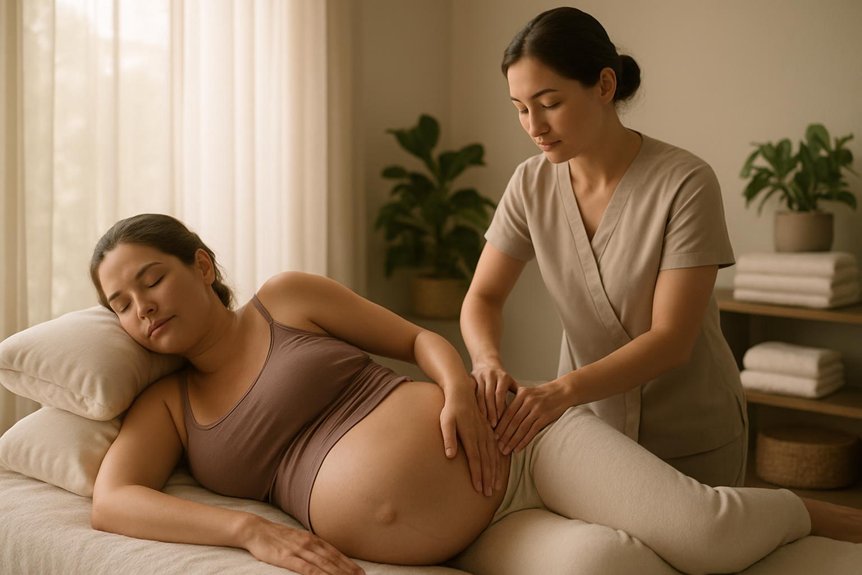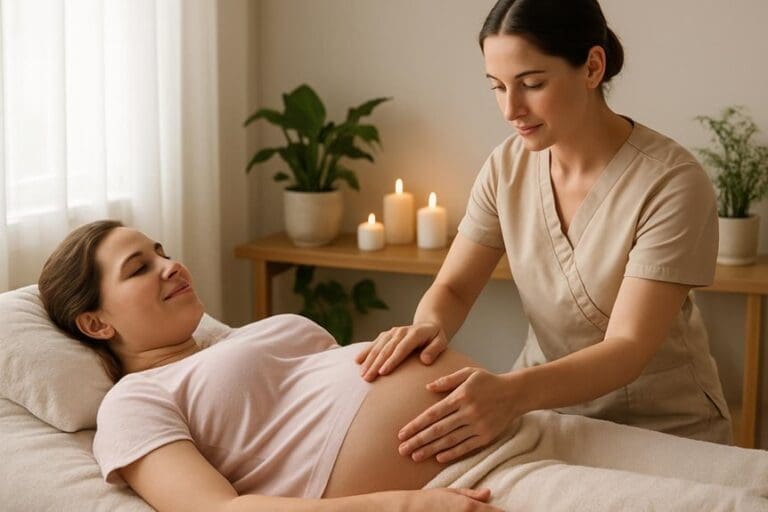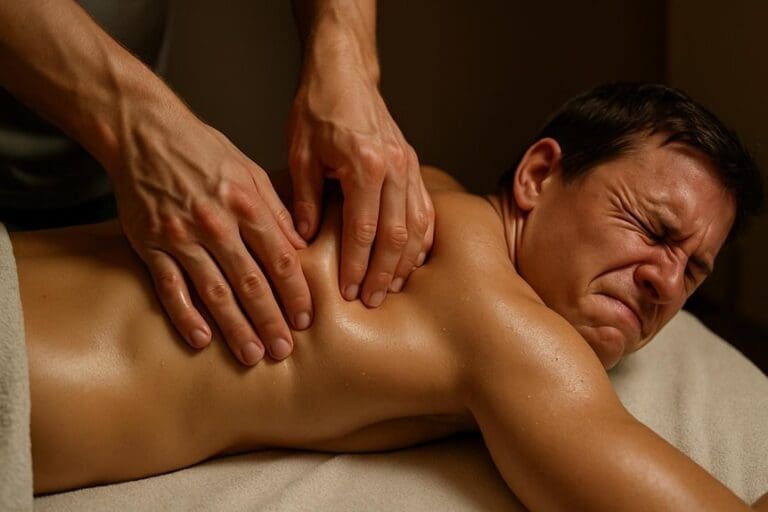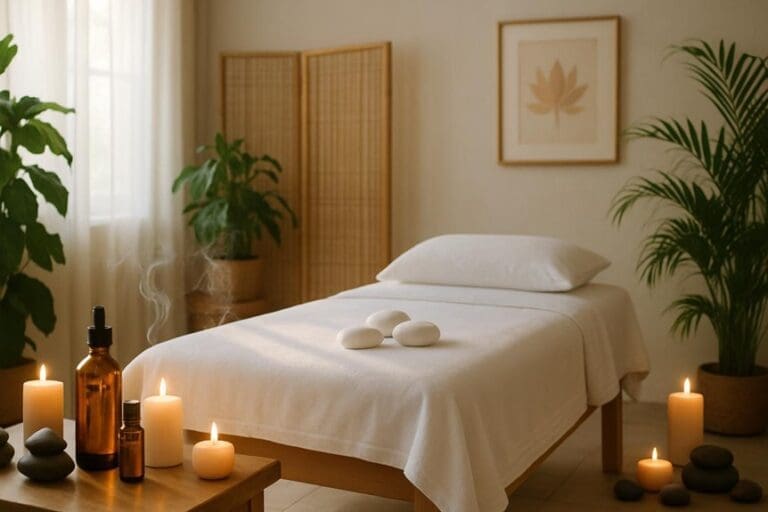Massage can affect pregnancy positively when performed by trained professionals using prenatal precautions. Light‑to‑moderate pressure in side‑lying or semi‑reclined positions may reduce stress, improve sleep, ease back and pelvic pain, and support circulation. Deep abdominal work and strong leg pressure are avoided. Aromatherapy is minimized; hypoallergenic unscented oils are preferred. Massage is deferred with warning signs such as bleeding, severe pain, fever, or suspected preeclampsia, and high‑risk cases need medical clearance. Further details outline trimester benefits, safe techniques, and aftercare.
Understanding How Massage Interacts With Pregnancy
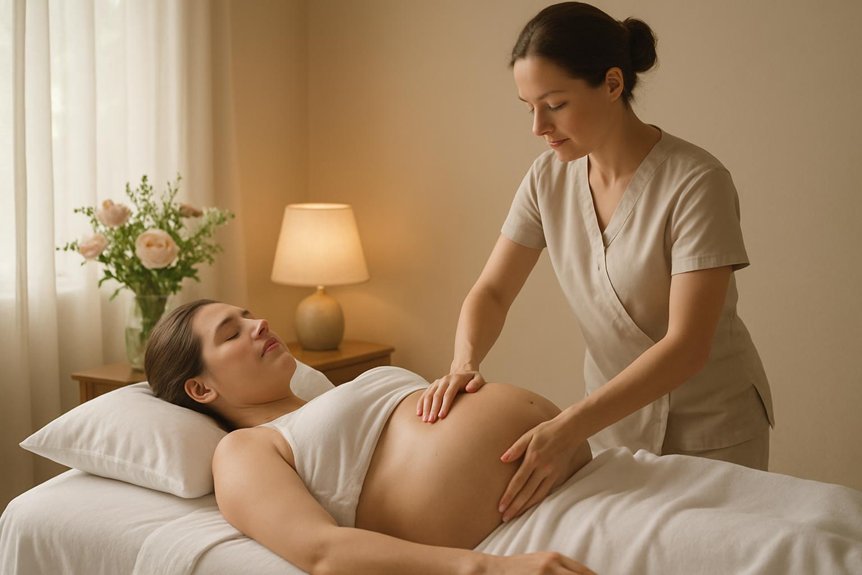
Although every pregnancy is unique, the physiology is well understood: hormonal shifts, increased blood volume, postural changes, and ligament laxity alter how tissues respond to touch.
Massage interacts with these changes through gentle modulation of the autonomic nervous system, promoting parasympathetic tone, easing myofascial tension, and supporting venous and lymphatic return when positioned safely.
Evidence suggests light-to-moderate pressure, avoiding deep abdominal work, is appropriate when guided by a trained therapist.
At Spa & Massage, clinicians use side-lying or semi-reclined positioning with cushion support to reduce aortocaval compression and strain on the pelvis.
They adapt pressure to areas prone to sensitivity—low back, gluteals, neck, and feet—while avoiding contraindicated zones and techniques.
Unscented or hypoallergenic oils are offered.
Therapists screen for red flags and coordinate with client preferences for comfort, intimacy, and informed consent.
In some cases, aromatherapy massage is utilized to further promote relaxation and healing, provided essential oils are deemed safe for pregnancy.
Benefits of Prenatal Massage for Each Trimester
Spa & Massage outlines trimester-specific benefits of prenatal massage grounded in current guidelines and clinical experience:
First-trimester support focuses on gentle techniques to reduce nausea-related tension, improve sleep, and lower stress.
In the second trimester, targeted side-lying work can ease back, hip, and pelvic discomfort, support circulation, and reduce leg cramps and mild edema.
First-Trimester Support
Why consider prenatal massage in the first trimester? Early sessions can reduce stress reactivity, improve sleep continuity, and ease headaches and neck or low-back discomfort common with hormonal change. Evidence suggests gentle, adaptive touch may lower cortisol and support parasympathetic tone, fostering calmer mood and steady energy.
At Spa & Massage in London, therapists provide side-lying or semi-reclined positioning, light-to-moderate pressure, and avoid abdominal compression and high-heat environments. Unscented or mild, pregnancy-safe oils are used; many clients choose fragrance-free options during nausea.
Techniques focus on the neck, shoulders, lumbar paraspinals, gluteals, calves, and hands/feet, with careful monitoring for dizziness or fatigue.
Therapists recommend shorter sessions initially (30–45 minutes), hydration, and paced breathing. They advise deferring treatment with vaginal bleeding, severe vomiting, fever, or clinician-advised restrictions, and coordinating care with midwives or GPs.
Second-Trimester Relief
Midway through pregnancy, many experience musculoskeletal strain from a growing uterus, postural shift, and ligament laxity; targeted prenatal massage can mitigate these changes.
Evidence supports gentle, side-lying techniques to reduce low‑back, pelvic, and gluteal tension; decrease sciatic irritation; and ease rib and intercostal discomfort as the diaphragm elevates.
At Spa & Massage, therapists use light‑to‑moderate pressure, supported bolstering, and slow myofascial work to improve circulation and lymphatic return, helping ankle and hand swelling while preserving comfort and safety.
Clients often report deeper sleep and calmer breathing after sessions.
Neutral, pregnancy‑safe oils are used; aromatics are added only with consent.
Therapists avoid deep abdominal work and sustained trigger‑point pressure over the calves.
Home care includes gentle hip mobility, hydration, and paced walks between appointments.
Third-Trimester Preparation
As pregnancy progresses into the third trimester, comfort needs shift toward managing pelvic pressure, low‑back load, sleep disruption, and swelling while preparing both body and mind for birth.
Evidence supports side‑lying prenatal massage to reduce lumbar and sacroiliac tension, improve venous return, and ease carpal tunnel symptoms.
At Spa & Massage, therapists use light to moderate pressure, slow myofascial work to the hips and glutes, and lymphatic‑style strokes for ankles and feet, avoiding contraindicated points and supine positioning.
Gentle diaphragmatic release and rib mobilisations can aid breath depth and sleep.
Sessions emphasise nervous‑system down‑regulation, using unscented or mild aromatherapy oils when appropriate.
Clients receive tailored birth‑prep guidance: pelvic floor awareness, perineal soft‑tissue easing, side‑lying positioning strategies, and post‑session hydration and rest.
Safety Guidelines and When to Avoid Massage
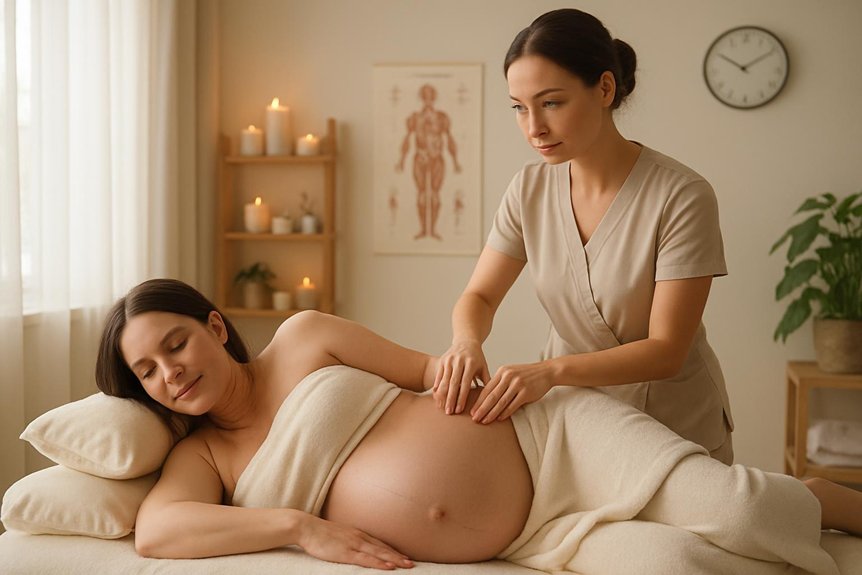
While massage can be a safe, supportive therapy during pregnancy, clear safety guidelines help protect both parent and baby. At Spa & Massage, therapists screen for red flags, seek consent, and coordinate care with existing clinicians when needed.
Massage is avoided or deferred with unexplained vaginal bleeding, severe abdominal pain, fever, suspected preeclampsia, reduced fetal movements, placenta previa after 28 weeks, recent miscarriage risk, uncontrolled gestational diabetes, infection, or new calf pain/swelling suggestive of DVT.
High‑risk pregnancies require medical clearance.
Sessions remain short, pressure is moderated, and sustained deep work on the abdomen, inner thighs, and known acupressure induction points is avoided.
Neutral, hypoallergenic oils are used; aromatherapy is minimized.
Clients are positioned side‑lying, hydrated, and monitored for dizziness, nausea, or contractions.
How We Adapt Techniques for Expectant Mothers
Spa & Massage outlines clear adaptations for pregnancy massage, prioritising safe positioning, moderated pressure, and careful product selection.
Therapists employ side-lying or semi‑reclined setups with supportive cushions, use gentle to moderate, slow strokes that avoid contraindicated points, and monitor patient feedback continuously.
In our clinics, hypoallergenic, unscented or lightly scented oils are preferred, with patch testing and avoidance of stimulating essential oils to accommodate heightened skin sensitivity and nausea.
Safe Positioning Strategies
Safe positioning during prenatal massage reduces maternal discomfort, supports uteroplacental blood flow, and protects joints and soft tissues. Evidence supports left side-lying as the primary posture after the first trimester to minimize aortocaval compression. Pillows and wedges are used to align the spine, hips, and knees and to cradle the abdomen and breasts.
Semi-reclined positioning can ease heartburn, sinus pressure, and dyspnea while maintaining circulation. Short, carefully monitored prone work may be possible with adjustable bolstering early in pregnancy, avoiding abdominal pressure.
At Spa & Massage, therapists conduct a brief positional screen, then adjust bolsters, headrest height, and knee support to maintain neutral alignment and easy breathing. Clients are invited to communicate sensations—numbness, dizziness, or breathlessness—that prompt immediate repositioning for safety and comfort.
Pressure and Technique Modifications
How does therapeutic touch change when someone is pregnant? At Spa & Massage, therapists adjust pressure, pacing, and stroke selection to respect cardiovascular, ligamentous, and sensory changes of pregnancy.
Evidence supports light-to-moderate pressure for most clients, with firm, non-painful pressure used selectively on tense paraspinals, gluteals, and shoulders—always avoiding the abdomen and points associated with uterine stimulation.
Slow, rhythmic effleurage and broad kneading soothe sympathetic arousal; friction and deep stripping are minimized where edema or varicosities are present.
Clinical focus shifts to comfort and safety: lateral or semi-reclined positioning, supported limbs, and short, outcome-based sequences for low back, hips, and neck.
Therapists monitor verbal feedback, breath, and tissue response, adapting moment to moment.
In our clinics, this careful modulation aims for relief, emotional ease, and maternal–fetal well-being.
Oil Choices and Sensitivities
During pregnancy, skin reactivity and olfactory sensitivity often increase, so oil selection and application are adjusted to minimise irritation while maintaining therapeutic glide.
At Spa & Massage, therapists begin with a fragrance-free, nut-free carrier oil—typically grapeseed or sunflower—patch-tested on a small area. If aromatics are desired, they use conservative dilutions (0.5–1%) and avoid contraindicated oils; citrus and peppermint are limited due to phototoxicity or nausea triggers.
Client history guides choices, including eczema, asthma, or hyperemesis.
Techniques emphasise lighter application and frequent towel blotting to reduce residue and heat. Unscented options remain available throughout.
Post-session, clients are advised to rinse gently if sensitivity arises and to monitor for delayed reactions. Documentation of responses informs future sessions across our London clinics.
Positioning and Support on the Massage Table
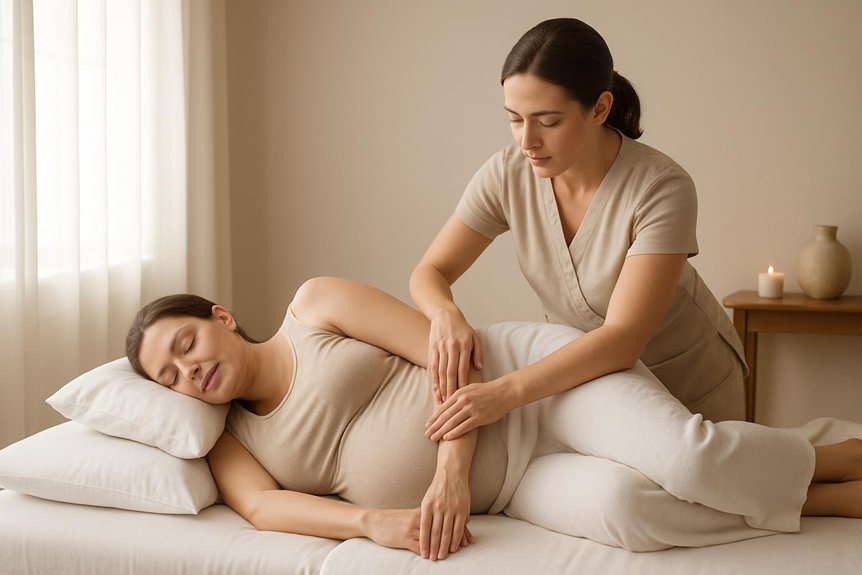
Although comfort is the priority, positioning in prenatal massage is guided by physiology and safety. From the second trimester, supine time is limited to reduce aortocaval compression. Left side-lying or semi-reclined positions maintain maternal circulation and fetal oxygenation.
Neutral spinal alignment, supported hips, and relaxed shoulders reduce strain and allow unguarded touch.
At Spa & Massage, therapists customise bolstering with firm pillows and adjustable wedges: a cushion between knees and ankles to align the pelvis, a small roll under the waist to unload the lumbar spine, and chest support to ease breast tenderness.
Belly is never suspended without full-length support. Pressure is adapted so breathing remains effortless. Clients are invited to change position if tingling, heartburn, or dizziness arises; regular check-ins preserve intimacy, privacy, and clinical safety.
Massage Oils and Aromatherapy Considerations in Pregnancy
Why do massage oils and aromatics matter so much in pregnancy care? Skin permeability increases during pregnancy, and scent can modulate nausea, mood, and sleep via limbic pathways.
At Spa & Massage, therapists use hypoallergenic, unscented plant oils (grapeseed, fractionated coconut) to minimise sensitisation and support barrier function.
Essential oils, if requested, are used sparingly, typically after the first trimester, with conservative dilutions (about 1%) and careful avoidance of known contraindications (e.g., clary sage, cinnamon, rosemary).
Safer options—lavender, mandarin, neroli—are selected based on client preference, medical history, and current symptoms.
Clients are invited to smell-test blends, as aversions are common. Patch testing precedes application.
Ventilation, shorter aromatic exposure, and localized use reduce systemic load.
Post-session, therapists recommend hydration, noting any delayed skin reactions.
Addressing Common Pregnancy Discomforts With Massage
Even as the body adapts to pregnancy, predictable patterns of discomfort—low back and pelvic pain, sciatic irritation, neck and shoulder tension, edema in the legs and ankles, carpal tunnel–type symptoms, and sleep disturbance—often emerge and intensify across trimesters.
Evidence supports gentle, positional massage to reduce pain and anxiety, improve sleep quality, and ease swelling. At Spa & Massage clinics, therapists prioritise side-lying comfort with cushions, then apply light-to-moderate pressure to paraspinals, gluteals, and piriformis to calm sciatica.
Myofascial work eases thoracic outlet strain contributing to wrist tingling. Rhythmic distal-to-proximal strokes assist lymphatic return in puffy legs, while diaphragmatic breath cueing downshifts the nervous system.
Sessions avoid deep abdominal work and sustained pressure over varicosities. Clients are invited to communicate moment-by-moment needs for safety and tenderness.
What to Expect During a Prenatal Massage Session
Relief from common pregnancy discomforts raises a practical question: what actually happens in a session. At Spa & Massage, a therapist conducts a brief health screen, confirming trimester, symptoms, and obstetric guidance.
Positioning uses side-lying or semi-reclined support with pillows to protect uteroplacental blood flow and comfort. Pressure is moderate and responsive; deep work and strong abdominal techniques are avoided.
Focus commonly includes lumbar paraspinals, gluteals, hips, calves, feet, neck, and shoulders to reduce edema and muscle tension.
Unscented or pregnancy-safe aromatherapy oils may be used; in our clinics, therapists select low-sensitising blends and patch-test when indicated. Clients remain appropriately draped, with consent sought before each area.
Sessions last 45–75 minutes, with pacing adjusted to breath, fatigue, and fetal movement for reassuring, clinical care.
Aftercare Tips and Signs to Monitor Post-Massage
Following a prenatal massage, Spa & Massage advises a simple aftercare plan to consolidate benefits and guarantee safety. Hydration is encouraged to support circulation and reduce post‑massage soreness.
Light snacks and slow positional changes help prevent dizziness. Gentle walking and side‑lying rest further ease lower‑back and pelvic strain.
In our clinics, therapists suggest warm—not hot—showers and avoiding saunas or intense exercise for 24 hours.
They also recommend noting fetal movements as usual and contacting a midwife if patterns change.
Seek urgent care if any red‑flag symptoms arise: vaginal bleeding, leaking fluid, persistent uterine cramping, severe headache, visual changes, chest pain, calf swelling or warmth, shortness of breath, or reduced fetal movements.
Mild muscle tenderness or increased urination is common. Clients may rebook when comfortable, typically within 1–2 weeks.
Conclusion
In summary, the evidence suggests prenatal massage can be a steady anchor in shifting seas—supporting comfort, sleep, and stress reduction while easing common musculoskeletal strains. When delivered by trained practitioners who adapt techniques, positioning, and pressure to trimester and health status, massage appears safe for most. Clear screening, informed consent, and attention to red flags remain essential. With individualized care plans and gentle aftercare, expectant mothers can make confident choices that prioritize well-being for both parent and baby.
